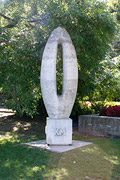Once
I leave Vienna and Austria behind, I will be travelling on to Budapest,
Hungary. While there, I will have the opportunity to view the famous Széchenyi
Chain Bridge. This bridge is considered a symbolic building in Budapest and was
the first permanent stone-bridge to connect Pest and Buda over the Danube
River. (“Chain Bridge,” 2014). Construction of the bridge began in 1839, but
the bridge itself was not completed until 1849. The main architect was an
Englishman named William Tierney Clark, and the construction supervisor was
Adam Clark. However, the original proposal for the bridge came from a Hungarian
leader named Count István Széchenyi. (“Chain Bridge,” 2014). Széchenyi was a
major supporter of the bridge project and even founded a society for the sole purpose
of financing the bridge. Ultimately the bridge itself was given his name after
a renovation completed in 1915, (“A Brief History,” 2014). When this bridge was
originally constructed it was the second longest suspension bridge in the
world, (“Chain Bridge,” 2014). The building of this bridge was a major
accomplishment.
World War II brought much damage and destruction to the Széchenyi
Chain Bridge. In January of 1945, German troops blew up all the bridges in
Budapest as they retreated. This included the Chain Bridge. The damage was extensive,
with only the pillars of the bridge remaining unharmed, (“Chain Bridge, 2014).
By 1947 the decision had been made to rebuild the bridge, and it was fully
restored and reopened in 1949. The bridge’s reopening marked its centennial anniversary,
(“Chain Bridge, 2014). The restoration of the Széchenyi Chain Bridge shows what
an important landmark it had become to the Hungarian people.
 |
| Damage from World War II |
 |
| Zero Milestone |
Today,
the Széchenyi Chain Bridge has two lanes for traffic, and a sidewalk so
pedestrians and tourists can cross the bridge to take in the view. In total,
the bridge spans a length of 380 meters and is 14.8 meters wide, (“Chain
Bridge, 2014). The bridge is known for its fantastic views of the city and is
located close to major attractions on both the Buda and Pest sides of the
Danube River, (“A Brief History, 2014). Adam Clark Square, found on the Buda side of the
bridge, contains the zero milestone for Hungary, meaning that it is the
starting point for all the major Hungarian roads, (“Chain Bridge, 2014). The Széchenyi
Chain Bridge is a significant Hungarian landmark and I cannot wait to see it
during my stay in Budapest.
References:
Bridges of Budapest.com. (2014). Chain Bridge. Retrieved from http://www.bridgesofbudapest.com/bridge/chain_bridge
Budapest.travel. (2014). A Brief History of Chain Bridge. Retrieved from http://visitbudapest.travel/guide/budapest-attractions/chain-bridge/
Picture References:
http://attractions.topbudapest.org/wp-content/uploads/2011/07/Chain-Bridge-Budapest-WW2.png
http://www.bridgesofbudapest.com/content/pictures/bridges/chain_bridge/0km_stone_adam_clark_square.jpg
http://visitbudapest.travel/images/content/gallery/33/chain-bridge4__big.jpg
http://visitbudapest.travel/images/content/gallery/33/chain-bridge-by-night__big.jpg

